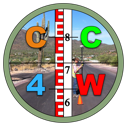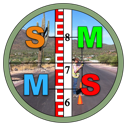
A unique series of Books and Apps for the Surveying, Engineering, GIS Professionals and aspiring Students.

The “Parcel Boundary” app has two primary functions.
1 - To calculate the closure and area of a parcel by a Metes and Bounds description.
2 - To plot graphically an aliquot parcel description.
Launch the app and then tap the “Start” button.


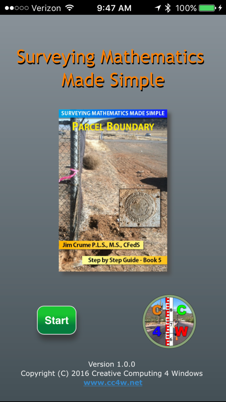

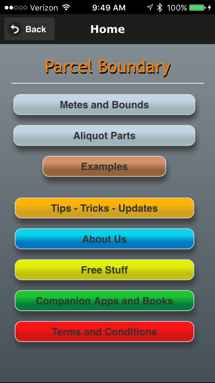
Go back to previous screen
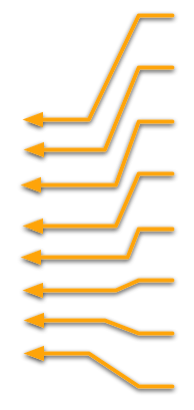

Metes and Bounds module
Aliquot Parts module
Examples of legal descriptions
Online Tips, Tricks and Updates
About the author/programmer
Online Free Stuff
Other Apps and Books
Terms and Conditions


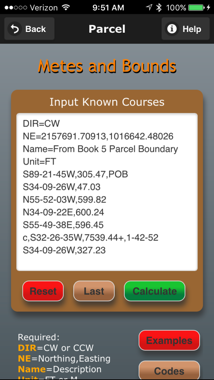
Go back to previous screen



Reset: Clears and resets the TBAI
Last: Recalls that last data input
Calculate: The TBAI is parsed and calculates the area and error of closure for a typical closed legal description or parcel boundary.
Text Based Artificial Intelligence (TBAI) interface.
A user interface using simple text to input the required codes and courses from legal descriptions, etc.
App help menu
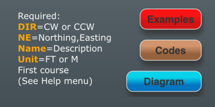

Input Quick Reference



Data input examples
Code examples
Basic diagram
The first four lines in the TBAI are reserved for the required codes. The TBAI needs these codes to know how to properly calculate the area and error of closure for the parcel.
The four required codes are DIR, NE, NAME and UNIT. Each code name is followed by an “=“ sign then the appropriate value as such: (CODE = VALUE)
DIR = CW or CCW
CW is for clockwise direction around the parcel or lot.
CCW is for counter clockwise direction around the parcel or lot.
(The direction of the parcel courses is required in order to properly calculate the area through curved segments.)
NE = 10000,10000 (Northing and Easting)
Substitute 10000,10000 for any value you want to use as the starting coordinate pair for the boundary.
Name = My first parcel
On the right side of the “=“ sign type a description of the parcel or lot.
Unit = FT or M
FT is for imperial (US) system.
M is for the metric system.
Starting on the fifth line, just after the required codes, enter the first course for the parcel or lot as shown on the legal description or plat. Enter each subsequent course on a separate line. Use commas to separate the elements for each course. The TBAI will recognize Line and Simple Curve formats as follows:
[Line Format] (Direction) Ndd-mm-ssE,distance,(POB or comment)
Example: N05-21-32E,143.23
If there are lead in courses to get to the Point of Beginning, then add ‘,POB’ at the end of the line to indicate that the closed parcel starts on the next line.
Example: N05-21-32E,143.23,POB
(See below for the course direction formats that are recognized by the TBAI.)
[Curve Format] c,(LTB, Chord Bearing or Radial Bearing) Ndd-mm-ssE,radius+/-,(Delta) dd-mm-ss, dd.ddd, Gdd.dddd or (Curve Length) Lxx.xx,(comments)
Precede the Curve Format with the letter ‘c’ followed by the known curve elements.
LTB: Ndd-mm-ssE (The default type)
Chord Bearing: cNdd-mm-ssE (Precede the bearing with a ‘c’)
Radial Bearing: rNdd-mm-ssE (Precede the bearing with a ‘r’)
Example: c,S32-26-35W,7539.44+,1-42-52
The TBAI utilizes the boundary information that is typically shown in Legal Descriptions, Plats, Results of Survey, etc. See below for the direction and angle formats that are recognized.
You can add comments at the end of each line. You can also add comments by preceding the line with an apostrophe.
Example: ‘This is a comment line. The TBAI will ignore this line.
The following is an example of a closed traverse with one lead in course:
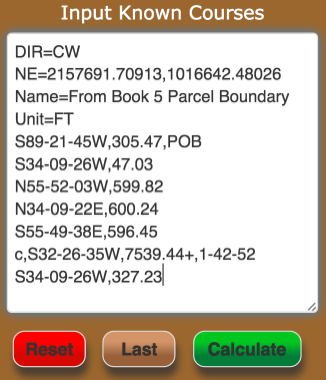
The first four lines are the required codes and values for the parcel.
The fifth line is a lead in course to the Point of Beginning for the example.
The remaining courses are for the closed parcel.
Tap the ‘Calculate’ button to have the TBAI parse the input data and calculate the closed parcel for the Area, Perimeter, Error of Closure, Ratio of Closure, Closing course with the Northing and Easting differences.

The Boundary Results are as shown on the left.
The results can be viewed for analysis. If an error is found, tap the back button, make any corrections in the TBAI and tap the ‘Calculate’ button again to review the results. You can go back and forth as many times as needed until the error has been fixed.
To have the TBAI ignore a line, precede it with an apostrophe.
Example: ’N55-52-03W,599.82
The Boundary Results can be emailed to yourself or others for review and documentation.
______________________________________
The TBAI will recognize the following direction and angle formats:
BEARINGS
Ndd-mm-ssE (Degrees-Minutes-Seconds)
Ndd.dddddE (Decimal Degrees)
(All four quadrants NE, SE, SW, NW)
NORTH AZIMUTH
NAZdd-mm-ss (Degrees-Minutes-Seconds)
NAZdd.ddddd (Decimal Degrees)
CARDINAL
N, North, S, South, E, East, W, West
GRAD a.k.a. GON
Gxx.xxxxx (Decimal format)
Delta
dd-mm-ss (degrees-minutes-seconds)
dd.ddddd (decimal degrees)
Gxx.xxxxx (Grad a.k.a. Gon)



Go back to previous screen



Reset: Clears and resets the TBAI
Last: Recalls that last data input
Calculate: The TBAI is parsed and plots the aliquot parts for a typical section.
Text Based Artificial Intelligence (TBAI) interface.
A user interface using simple text to input the required codes and aliquot descriptions.
App help menu


Input Quick Reference



Data input examples
Code examples
Basic diagram
The first two lines in the TBAI are reserved for the required codes. The TBAI needs these codes so that the Section, Township and Range will be shown on the plot.
The two required codes are SEC and TR. Each code name is followed by an “=“ sign then the appropriate value as such: (CODE = VALUE)
SEC = 32
TR = T.?E. R.?W. (Township and Range)
Type in the section number, Township and Range for the aliquot parts you are entering.
Starting on the third line, just after the required codes, enter the first aliquot part for the legal description. Enter each subsequent aliquot part on a separate line.
Example:
S2 SW4 NW4
NE4 NW4 SW4
The TBAI utilizes the aliquot part information that is typically shown in Legal Descriptions. See below for the aliquot part formats that are recognized.
You can add comments by preceding the line with an apostrophe.
Example: ‘This is a comment line. The TBAI will ignore this line.
The following is an example of an aliquot part description:
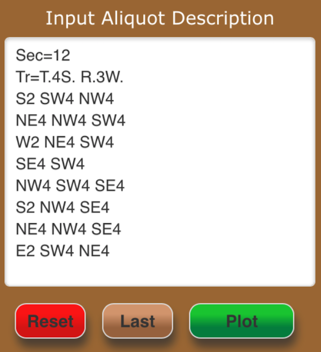
The first two lines are the required codes and values.
The third line is first aliquot part.
The remaining lines are additional aliquot parts.
Tap the ‘Plot’ button to have the TBAI parse the input data and plot the aliquot parts on a drawing of a typical section.
Each aliquot part will be in a different color. A legend will be shown with the color along with the aliquot part description.
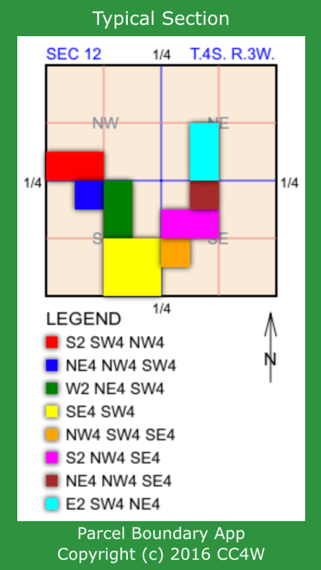
The plot of a typical section is shown on the left.
The results can be viewed for analysis. If an error is found, tap the back button, make any corrections in the TBAI and tap the ‘Plot’ button again to review the results. You can go back and forth as many times as needed until the error has been fixed.
To have the TBAI ignore a line, precede it with an apostrophe.
Example: ’S2 SW4 NW4
To share the plot, take a screen shot with your mobile device then email it to others for review or documentation.
______________________________________
The TBAI will recognize the following aliquot part formats:
NE
NE4 (All quadrants)
N
N2
(The numbers 4 for 1/4 and 2 for 1/2 can be omitted)

Coming soon!!!
Copyright © 2001-2018 CC4W All rights reserved
Website designed by Creative Computing 4 Windows
